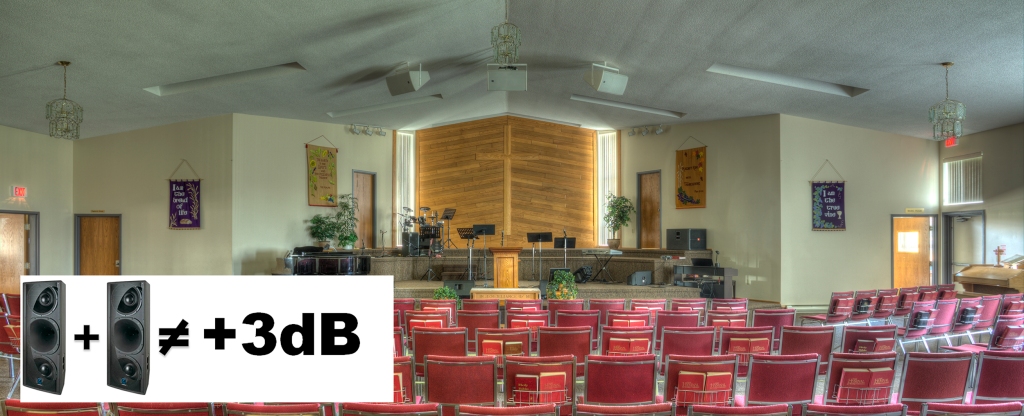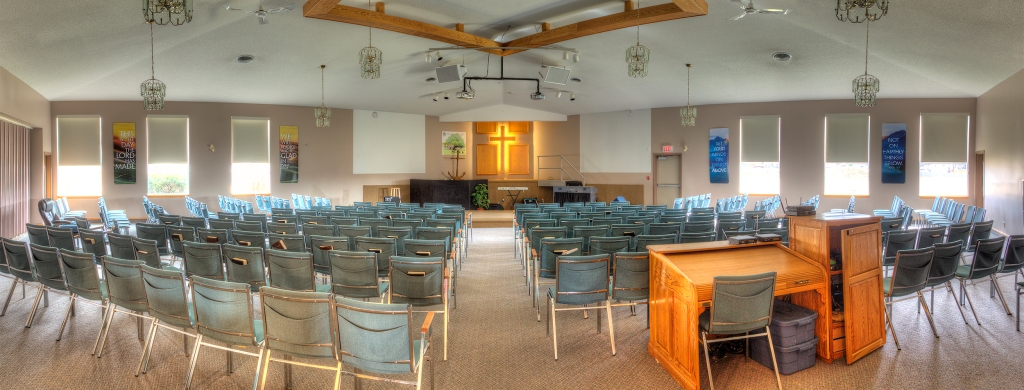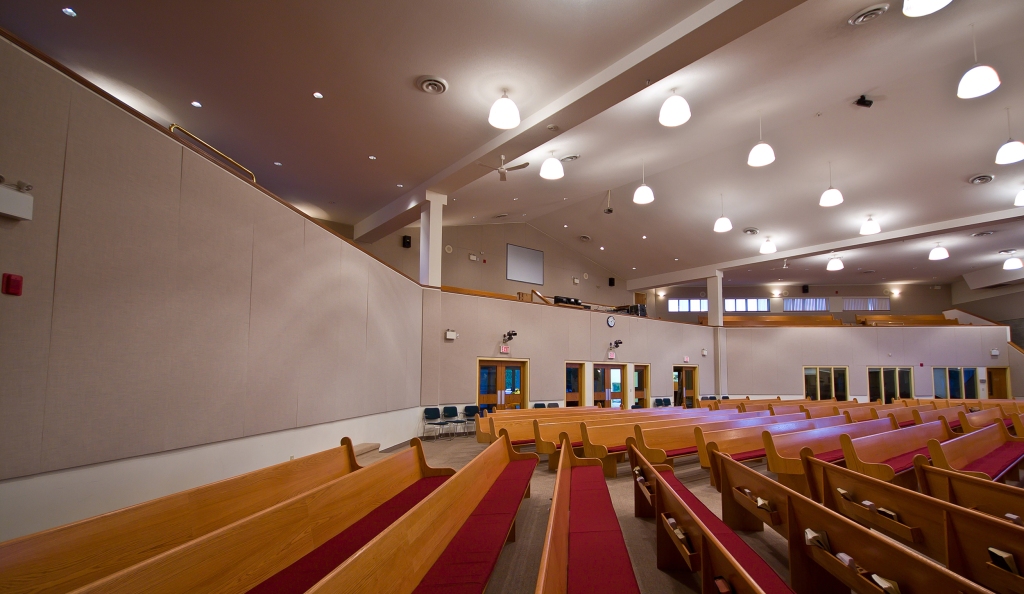1 + 1 = 3 or When is Doubling the Power, not +3dB?
Posted by jdbsound on June 17, 2019
Here is a simple test anyone can do to determine the acoustical condition of a church. Physics says that when the power* is doubled or when doubling the number of speakers, the sound level will increase 3dB. This result is real when outdoors. This outcome can be false indoors. When it is false indoors, it is because there are acoustical problems. Please notice that it is problems, not a problem. When adding a second speaker failing to increase the sound 3dB, this test shows that it is never a single acoustical issue. It is not a sound system problem. The sound system is exposing the root problem. (If the second speaker is wired out of phase, the sound will decrease in level.)

When outdoors, if there are two loudspeaker playing with the same volume of pink noise side by side or up to 6 feet apart, and set up a test microphone or SPL meter 30 feet away. (An iPad or phone with testing software can be used if it is calibrated.) When the second speaker is turned on or off, the sound level will change 3dB. This result is constant in physics. The reason this is always true is that there are no barriers around to limit the sounds from spreading out or returning from a reflection that can interfere with the direct sound.
When indoors, depending on the size of the room, often this is not true. This failure is noticed the most with Subs and sound energy below 500 Hertz. Doing the same test at 30 feet inside of a church, the sound level change is often 1, 1.5, or 2dB. If the result is 3dB, there are either a lot of open windows, lots of doors that are open, the church has more than 3000 seating or the church has great acoustics.

Here are the most common reasons for the sound failing to increase 3dB when doubling the power or speakers.
- Standing waves
- Dimensions of the room
- Too much-stored energy in the corners
- Too much high-frequency absorption
Standing Waves
Standing waves are excessive amounts of energy between parallel walls within a confined space. The effect of standing waves are not always apparent. Standing waves are usually excess mid and bass frequencies of energy that masks the highs. You can’t hear a standing wave but you can hear the effects of it. To identify if your church has standing waves, go between any parallels walls. Stand about 4 feet from one of the side walls. Make a loud, sharp noise like a hand clap once. If a person hears any rapid pinging sounds, this is a sign of the presence of standing waves. The sound heard is often a higher range of frequencies, and they usually called flutter echoes. Flutter echoes are a symptom of standing waves. Bass sounds, which have longer wavelengths can’t produce the same volume of sound to hear as a flutter between parallel walls. Whenever a person hears flutter echoes, excess bass energy present too. This result is also true for all other room shapes when flutter echoes or flutters from a simple hand clap occur
A second clue to standing waves is when standing at a pulpit or where a minister preaches from. With a hand clap, if the reflected sounds are coming from the side walls or behind you, the standing waves are the cause of it. The standing waves are masking the highs, creating the effect as if it is preventing a large portion of the sound from reaching the other side of the room, and what is reflected back is being canceled out by the standing waves a second time which in turn prevents you from hearing the returning clap. Standing waves have other detrimental effects too. It has the effect of isolating everyone from each other in the room. This result is also why the drums seems to sound so loud and yet, this is also why most drummers strike the drums harder than they have too. It is because they can’t tell how loud they are playing at any volume level. This outcome is also why many people sitting in the pews comment that they can’t hear themselves when singing, and it makes them feel alone in a room full of people. This is the number one cause of people being discouraged from singing.

The reason the sound doesn’t increase 3dB when adding a second loudspeaker is because of the excess bass energy created by the standing waves in the worship space. The excess air pressure is like putting a finger lightly on the woofer. The excess air pressure acts as an acoustical load on the woofer, and that dampens the amount of sound coming from the loudspeaker.
Standing waves can only be removed with diffusion or some form of sound scattering.
If people try to use absorption to fix this problem, while it will remove the flutter or in some cases, shift the flutters to a lower frequency, the untreated bass energy will make the standing wave problem more pronounced. It will increase the feeling loneliness and discourage the congregation from singing even more.
The dimensions of the room
In churches with low ceilings or seating less than 200 people, the room is too small to be free from surface related sound inference reflections. In a larger church space with a flat ceiling less than 16 feet high, the room will have standing waves floor to ceiling which limits the ability to increase sound 3dB with just doubling the speakers.
The reason the sound doesn’t increase 3dB when adding a second loudspeaker is that the room is limiting how much the space can support. The excess air pressure from the extra speaker is like putting a finger lightly on the woofer. The excess air pressure acts as an acoustical load on the woofer, and that dampens the amount of sound coming from the loudspeaker.
The only option is to diffuse all of the room if a small church. If a low ceiling, diffusers will have to be added to the ceiling. Acoustical tiles and drop ceilings cannot correct this issue.
Too much-stored energy in the corners
Another principal of physic is how sound is affected by boundaries. A loudspeaker on a 10-foot pole measures 60dB. We call that free space. When we put the speaker on the ground, the speaker will be 6dB louder. That is referred to as “half space.” When we add a wall and the floor, we call that “1/4er space” and the sound increases 12dB or doubles in loudness. When we add a second wall to the floor and create a corner, that is “1/8th space,” and the sound rises 18dB.
Corners collect the air pressure that is created by longer wavelength sounds that accumulate on the flat surface of the wall. With nothing to direct the sound, the sound pressure moves in all directions. Eventually, the excess bass energy makes its way to the corners. Depending on a lot of variables, the amount of energy that builds up is often too much. Churches will low ceilings, large flat walls, or flat ceilings tend to have too much excess bass in the corners. All other church shapes, except for domes have varying levels of corner issues if not managed. Excess corn energy has a similar effect as standing waves. When there is too much bass, it masks the highs. This, in turn, creates hotspots and coldspots throughout the room. Hotspots and Coldspots are frequency dependent. If the sound level changes are of a narrow range of frequencies, it was most likely found them with instruments. When a person notices them with their ears, it means anyone with a hearing problem will miss out on some of what is being said, or what they heard and what was said was different.

The reason the sound doesn’t increase 3dB when adding a second loudspeaker is because of the excess bass energy created by the bare walls in the worship space. The excess air pressure is like putting a finger lightly on the woofer. The excess air pressure acts as an acoustical load on the woofer, and that dampens the amount of sound coming from the loudspeaker.
Keeping excess sound out of the corners is best done with diffusion. It cannot be done with absorption unless the absorbers are as thick as the wavelength of the sound waves.
Too much high-frequency absorption
Sound arrives at our ears as air pressure vibrating at a rapid rate. The faster the air vibrates, the higher the sound pitch. The slower the sound vibrates, the lower the pitch. The vibrations are referred to as Hertz. Sound travel at 1130 feet per second. At 100 Hertz, a bass sound has the wavelength of just over 11.3 feet. At 1,000 Hertz the sound waves are 1.13 feet, and at 10,000 Hertz the sound waves are 0.11 feet or 1.3 inches.
When there is too much absorption in the room, what is left is too much bass. The excess bass masks the highs.

The reason the sound doesn’t increase 3dB when adding a second loudspeaker is because of the excess bass energy created by too much absorption. The excess air pressure is like putting a finger lightly on the woofer. The excess air pressure acts as an acoustical load on the woofer, and that dampens the amount of sound coming from the loudspeaker.
The fix for such a problem is by removing the right amount of absorption panels and replace them with diffusers. Then complete the room by adding more diffusion throughout the sanctuary to correct the frequency response of the room.
These four issues are never a singular issue. They are often in combinations or can include all four. Along with these problems, there are often reverberation issues, echoes, excess late reflections, the poor frequency response of the room, and other room problems that have little to do with this simple 3dB test, but they are usually there as well. These problems can be heard when a person learns what to listen for. Looking at how sound system is equalized is another clue of room problems. The issues have the result of the high numbers of the congregation not singing. (In a church with good acoustics, they will often have more than 80% of the congregation singing every they are familiar with.)
Getting two loudspeakers and doing this test is simple and easy to do. If the sound doesn’t increase 3dB, this means that adding more subs or more speakers into a worship space will not get the expected outcome. For example. If the goal is to increase the bass in a worship space 3dB, and sound system has only one subwoofer, do this test, If the bass increased only 1.5dB with the second box, then it will take two more speakers just to get a 3dB increase for a total of 4 boxes. Think of the cost of adding three speaker boxes and all of the related hardware required to support that. An alternative would be to fix the room with diffusion, the gain will be 6 to 10dB of performance without doing anything to the sound system. It would be equal to adding 8 or 16 subwoofers depending on other acoustical or architectural considerations.
Science is amazing when appropriately used to provide real solutions. Pseudo-Science or fake data is often used under the disguise of science and can be used to lead churches to false conclusions. Many experts in audio and acoustics who see the same data, know these problems are present. If they are not being addressed, it is because they lack the experience in knowing how to solves such issues. If a person has done this test and the sound system provider or acoustical expert is not addressing these issue, they are not qualified for correcting sound problems in a church. It’s like asking a Doctor who specializes in kidney problems to do Brain Surgery. What is needed a Brain Surgeon who knows how to fix both the acoustics and to design a proper sound system.
Get the church correctly evaluated before investing in that next sound system. It can save those responsible a lot of disappointments down the road. Fixing a room can cost less than replacing a sound system, or it could mean reducing the size of the suggested new sound system.
* Doubling the power required calibrated volume controls or switches to set up correctly as a viable test.
Sorry, the comment form is closed at this time.
